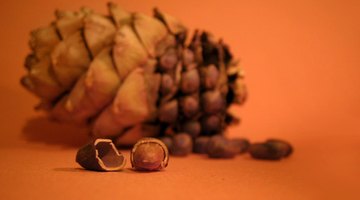Difference Between Red Cedar & Aromatic Cedar
Red cedar and aromatic cedar are terms used to describe two species of trees. Red cedar and aromatic cedar differ slightly in classification. The former describes two trees of different genera with similar common names, while the latter describes one species of tree.

Despite the overlapping nature and basic similarity of the phrases, differences exist.
Classification
Red cedar is used to denote western red cedar (Thuja plicata) and eastern red cedar (Juniperus virginiana). Though these species belong to different genera, they are both members of the cypress (Cupressaceae) family of plants. Aromatic cedar refers only to eastern red cedar and, in some cases, only eastern red cedar trees from a specific region.
Context
The terms “red cedar” and “aromatic cedar” are markedly different in their context. Red cedar is a lay, or common, term. In a scientific context, the taxonomical names of trees -- Thuja plicata and Juniperus virginiana -- are used. Aromatic cedar, on the other hand, is a trade term used by carpenters, contractors and other professionals in the building trade. The term refers specifically to the lumber of the eastern red cedar. It differs from the term “red cedar” in that red cedar refers to the tree as a whole, while “aromatic cedar” specifically denotes the wood of the eastern red cedar that is used in building projects and sometimes only building project lumber culled from specimens of eastern red cedar found in the southern portions of the Appalachian Mountains.
Distribution
The range of aromatic, or eastern red, cedar extends from southern Quebec to southern Georgia and from eastern Massachusetts to western Nebraska. According to the United States Forest Service, the species has extended its natural range greatly in the west by propagating in the wild from specimens introduced as landscaping plants. Western red cedar, also known as Pacific red cedar and giant cedar, is native to western Oregon and Washington, coastal British Columbia and portions of Idaho and Montana.
Use
Aromatic cedar lumber is used primarily in the construction of chests and closets. Red cedar wood was used commonly in the first half of the 20th century for such purposes. In landscaping projects, eastern red cedar is used to prevent soil erosion, particularly on the Great Plains, where the species’ ability to withstand drought and extreme heat and cold is exploited. In Nebraska, rows of eastern red cedar are used to form windbreaks.
Western red cedar is used for roofing shingles and shakes, and in the construction of poles, chests, closets, caskets, beehives and fence posts. Cedar leaf oil is an ingredient in perfumes, veterinary soaps, shoe polishes and deodorants. The trees’ leaves are a major source of food for big game during the winter. The Forest Service asserts that western red cedar is an excellent hedge-forming species for landscaping projects.
References
Resources
Writer Bio
Will Gish slipped into itinerancy and writing in 2005. His work can be found on various websites. He is the primary entertainment writer for "College Gentleman" magazine and contributes content to various other music and film websites. Gish has a Bachelor of Arts in art history from University of Massachusetts, Amherst.
Photo Credits
- cedar nut image by Ekaterina Shvigert from Fotolia.com
- cedar nut image by Ekaterina Shvigert from Fotolia.com
More Articles



